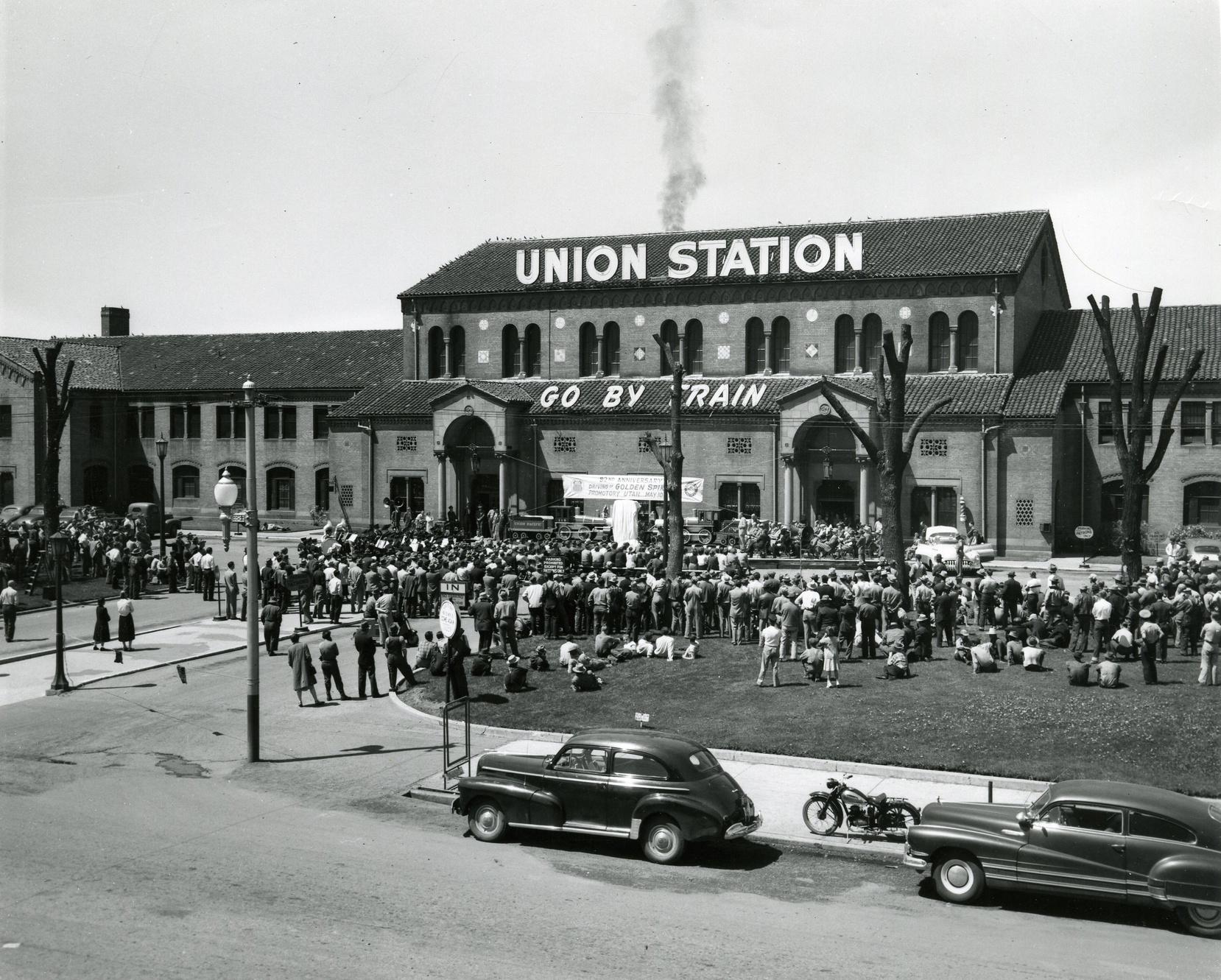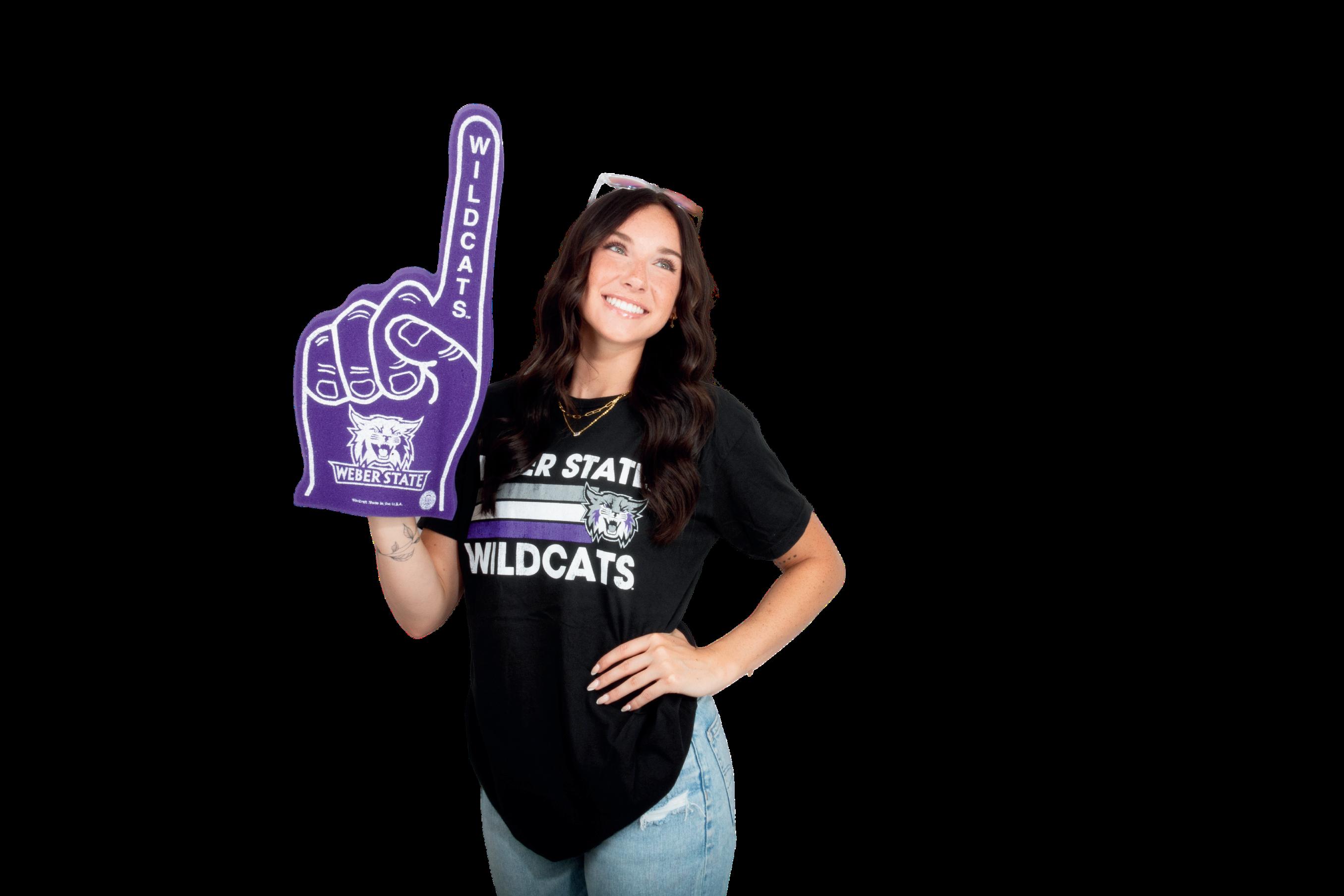THE CENTER POINT OF OGDEN





By HANNAH RICHARDS Reporter
By JARED MITCHELL Editor
Union Station has been a feature of Ogden for over 100 years, providing the city with a place for community and education.
“One of the wonderful things about working in Union Station is that pretty much whenever I mention that name to a community member, nearly everybody has some sort of memory here,” Hope Eggett, the museum administrator at Union Station, said. “It’s a really phenomenal opportunity to hear some deep and very meaningful memories of the community towards this place.”
Union Station hosts community events and contains historical museums that educate the public on firearms, cars, trains and local history. Eggett said that one of the station’s goals is to foster personal connections to history.
One way Eggett and her team are trying
to create more personal connections is by expanding the scope of what the museum focuses on.
“Lately we’ve been trying to expand our narrative of Ogden and the social history of Ogden, including more human-oriented narratives,” Eggett said. “Rather than focusing on just the wonderful mechanics of guns or the mechanics of trains, but by focusing on those human stories, it can find something everybody can relate to and that reflects the population that serves and lives in Ogden today.”
One of those human stories is the story of the Jones family in Ogden. The exhibition displayed the origins of this family, beginning with Hazel Jones, who was married to one of the men who worked on the railroad. Since the 1950s, Jones had documented the history of Ogden’s black community.
In February, Union Station featured the exhibit in the Grand Lobby. According to Eggett, many members of Ogden’s black community attended the opening reception to view im-
ages and stories of past friends and relatives. She expressed pride in helping to develop the Jones family exhibit.
Along with developing exhibits for the public to view, there are other development projects underway.
“Ogden has been working to really redevelop its whole downtown area and make this Union Station as vibrant as it wants to be,” Eggett said.
She also said that one of the most recently proposed projects is to restore its original function as a working train station in the future for FrontRunner or Amtrak. These possible renovations do not involve tearing down the historic station.
“The Union Station will not be torn down. It’s never been a consideration to lose this gem of our community,” Eggett said, dispelling any controversial notions of future development of the land.
Union Station is working hard to evolve and remain relevant to future generations.
“Right now, really our key audience at the museum that we are trying to advertise to get in the doors is intergenerational families,” Eggett said.
Families consisting of young children, teens, adults, and grandparents can come and experience what the museum has to offer.
“I hope that as they come to the museums and as they come to Union Station itself, that they make those key memories and they’re connected with the past in a way that’s very meaningful for them, that they can make sense of why Ogden is important, why we are the way that we are, and why they should be proud of our community,” Eggett said.
Union Station was built originally in 1869 when the transcontinental railroad came through Ogden. The station started as a small shack, and it eventually became the first iteration of the Union Station we know today. The original Union Station stood until 1923, when it burned down due to a staff member’s mistake.

“The porters used to be able to have rooms on the north side of the building. He was late for work, left his iron plugged in, and it caught fire and ended up burning most of the building down,” Sarah Langsdon, a curator for Weber State University’s special collections department, said.
An attempt was made to rebuild the destroyed station, but during the repairs, the damaged bell tower fell and killed a ticket taker at the station.
“His name was Frank Yentzer,” Langsdon said. “The death of Frank pretty much was the nail in the coffin to say that the Union Pacific decided, okay, we got to tear down the building and rebuild.”
The station was rebuilt over the next year, and the new station was completed in November of 1924. The rebuilt station is what stands today and its 100th anniversary was celebrated at the end of 2024.
Since its completion in 1924, Union Station has contributed to the development of Ogden in many different ways. “Ogden’s economy at the time really focused around the railroad. It was the highest employer in Ogden City and Weber County,” Langsdon said. “We call it the place where Ogden began.”
The railroad allowed for wholesale goods to be shipped to the city, livestock could come from out of state easily, and people from all over the country and the world could move to Ogden due to the railroad access.
The railroad also brought millions of people to Ogden during World War II.
“We have records that at least 1.9 million soldiers came through Ogden on the train during the war,” Langsdon said.
According to Langsdon, due to Ogden’s geographical location, it was an equal distance by train to Seattle, San Francisco and Los Angeles. This made Ogden a hub for American and foreign allies passing through to larger military
bases on the West Coast. The railroad economic boom lasted until the establishment of highways in America.
“By the ‘60s, railroad traffic, train travel really plummeted,” Langsdon said. “That sent Ogden into an economic downturn because all of a sudden, you didn’t have these thousands of people every day coming in and needing access to things.”
In the late ‘70s, a campaign was started to tear down the station and to develop it into something else. The local community rallied together and stopped the development of the land and chose to preserve the station instead.
“We don’t really know what the plan was, but the community rallied and said, ‘You know what? We’re going to take this building and turn it into museums in a community space,’” Langsdon said.
Union Station today hosts community events and provides historical education to community members, but that could change in the future.
“What Ogden City is envisioning is turning the Union Station back to a train station,” Langsdon said. “Instead of the FrontRunner stopping two blocks down, the FrontRunner will actually stop at the station.”
If the plans to convert Union Station back into a train station come to fruition, the museums will be moved to a different part of the property.
“The museums will move just south. They want to build a whole new building,” Langsdon said.
Some community members have voiced their concerns about possible changes, but Eggett said that they have nothing to worry about.
“It’s going to be enhanced. It’s going to be celebrated. It’s going to be here with us for hundreds of years more if we have our ways,” Eggett said.



Por VICTORIA HERNANDEZ Traductor
Por HANNAH RICHARDS Reportero
Por JARED MITCHELL Editor
La Union Station ha sido una característica de Ogden por más de 100 años, proveyendo a la ciudad con un lugar para la comunidad y educación.
“Una de las cosas maravillosas sobre el trabajar en la Union Station es que casi siempre que menciono ese nombre a un miembro de la comunidad, casi todo el mundo tiene algún tipo de recuerdo aquí”, Hope Eggett, el administrador en Union Station, dijo. “Es una opor-
tunidad realmente fenomenal para escuchar algunos recuerdos profundos y muy significativos de la comunidad hacia este lugar”.
Union Station acoge actos comunitarios y alberga museos históricos que educan al público sobre armas de fuego, coches, trenes e historia local. Eggett afirma que uno de los objetivos de la estación es fomentar los vínculos personales con la historia.
Una de las formas en que Eggett y su equipo intentan crear más conexiones personales es ampliando el alcance de los temas en los que se centra el museo.
“Últimamente hemos intentado ampliar nuestra narrativa de Ogden y la historia social de Ogden, incluyendo relatos más orientados a las personas”, explica Eggett. “En lugar de centrarnos sólo en la maravillosa mecánica de las armas o la mecánica de los trenes, sino centrarnos en esas historias humanas, puede
encontrar algo con lo que todo el mundo pueda relacionarse y que refleje la población que sirve y vive en Ogden hoy en día”.
Una de esas historias de personas, es la historia de la familia Jones en Ogden, Utah. La exhibición demuestra los orígenes de esta familia, comenzando con Hazel Jones, quién estaba casada con uno de los hombres que trabajó en la vía férrea. Desde los años 1950, Jones ha documentado la historia de la comunidad Afroamericana de Ogden. En febrero, Union Station presentó la exposición en el Gran Vestíbulo. Según Eggett, muchos miembros de la comunidad afroamericana de Ogden asistieron a la recepción inaugural para ver imágenes e historias de amigos y parientes del pasado. Eggett se mostró orgullosa de haber contribuido al desarrollo de la exposición de la familia Jones. Además del desarrollo de exposiciones para
el público, hay otros proyectos de desarrollo en marcha.
“Ogden ha estado trabajando para reurbanizar todo el centro de la ciudad y hacer que Union Station sea todo lo vibrante que quiere ser”, dijo Eggett.
Ella también dijo que uno de los proyectos que fue propuesto recientemente es restaurar a la función original la estación de tren en el futuro para el FrontRunner o Amtrak. Estas posibles renovaciones no involven destruir la histórica estación.
“La Union Station no será destruida. Nunca ha sido considerado perder esta gema de nuestra comunidad”, dijo Eggett, desvaneciendo alguna duda controversial sobre el desarrollo del lugar.
La Union Station está trabajando duro para evolucionar y mantenerse relevante para las futuras generaciones. “En este momento,

nuestra audiencia clave en el museo que estamos tratando de promocionar para pasar por nuestras puertas son las familias intergeneracionales”, dijo Eggett. Familias que consisten de niños, adolescentes, adultos, y abuelos puedan venir y experimentar lo que el museo tiene para ofrecer.
“Espero que cuando vengan al museo y a la Union Station, que ellos puedan hacer esos recuerdos y que los conecten con el pasado en una manera en la que es muy significativo para ellos, que puedan comprender por que Ogden es importante, porque somos como somos, y porque ellos deberían ser orgullosos de nuestra comunidad”, dijo Eggett.
Union Station se construyó originalmente en 1869, cuando el ferrocarril transcontinental pasó por Ogden. La estación comenzó como una pequeña choza, y con el tiempo se convirtió en la primera iteración de la Union Station que conocemos hoy en día. La Union Station original se mantuvo en pie hasta 1923, cuando se incendió por un error de un empleado.
“Los porteros solían tener habitaciones en la parte norte del edificio. Llegó tarde al trabajo, se dejó la plancha enchufada, se incendió y acabó quemándose la mayor parte del edificio”, explica Sarah Langsdon, conservadora del
departamento de colecciones especiales de la Universidad Estatal de Weber.
Se intentó reconstruir la estación destruida, pero durante las reparaciones, el campanario dañado se cayó y mató a un taquillero de la estación.
“Se llamaba Frank Yentzer”, explica Langsdon. “La muerte de Frank fue más o menos el clavo en el ataúd para decir que la Union Pacific decidió, vale, tenemos que derribar el edificio y reconstruirlo”.
La estación se reconstruyó durante el año siguiente, y la nueva estación se terminó en noviembre de 1924. La estación reconstruida es la que se conserva hoy en día y su centenario se celebró a finales de 2024.
Desde su finalización en 1924, Union Station ha contribuido al desarrollo de Ogden de muchas maneras diferentes. “La economía de Ogden en aquella época se centraba realmente en torno al ferrocarril. Era el mayor empleador de la ciudad de Ogden y del condado de Weber”, explica Langsdon. “Lo llamamos el lugar donde empezó Ogden”.
El ferrocarril permitía enviar mercancías al por mayor a la ciudad, el ganado podía venir de fuera del estado con facilidad, y gente de todo el país y del mundo podía trasladarse a Ogden gracias al acceso ferroviario.


El ferrocarril también atrajo a millones de personas a Ogden durante la Segunda Guerra Mundial.
“Tenemos constancia de que al menos 1,9 millones de soldados pasaron por Ogden en tren durante la guerra”, dijo Langsdon.
Según Langsdon, debido a la situación geográfica de Ogden, estaba a la misma distancia en tren de Seattle, San Francisco y Los Ángeles. Esto convirtió a Ogden en un centro neurálgico para los aliados estadounidenses y extranjeros de paso hacia las bases militares más grandes de la costa oeste. El auge económico del ferrocarril duró hasta el establecimiento de las autopistas en América.
“En los años 60, el tráfico ferroviario y los viajes en tren cayeron en picado”, explica Langsdon. “Ogden entró en una recesión económica porque, de repente, ya no había miles de personas que venían todos los días y necesitaban acceder a cosas”.
A finales de los 70, se inició una campaña para derribar la estación y convertirla en otra cosa. La comunidad local se unió y detuvo la urbanización del terreno y optó por conservar la estación.
“No sabemos realmente cuál era el plan, pero la comunidad se unió y dijo: ‘¿Saben qué? Vamos a tomar este edificio y convertirlo en un museo en un espacio comunitario’”, dijo Langsdon.
En la actualidad, Union Station acoge actos comunitarios y ofrece formación histórica a los miembros de la comunidad, pero eso podría
cambiar en el futuro.
“Lo que la ciudad de Ogden está imaginando es volver a convertir Union Station en una estación de tren”, dijo Langsdon. “En lugar de que el FrontRunner pare dos manzanas más abajo, el FrontRunner parará realmente en la estación”.
Si los planes de convertir Union Station de nuevo en una estación de tren llegan a buen puerto, los museos se trasladarán a otra parte de la propiedad.
“Los museos se trasladarán al sur. Quieren construir un edificio completamente nuevo”, dijo Langsdon.
Algunos miembros de la comunidad han expresado su preocupación por los posibles cambios, pero Eggett afirma que no tienen nada de qué preocuparse.
Se comparte esta historia en thesignpostwsu.com
TOP: Una toma aerea del patio de trenes y la pista de ferrocarril conectada al Union Station.



By BRAYSON BROWN Asst. Editor
The United States men’s national soccer team faced off against its biggest rival, the Mexico national team, for the eighth time in the Concacaf Gold Cup Final and fell short 2–1.
This is the 79th time overall that the teams have faced each other. Mexico holds the advantage, winning 37 times to the United States’ 24 wins, with a tie occurring 17 times.
With a pro-Mexican crowd on U.S. soil, it was almost like an away game for the United States. For the second straight game, the United States scored in the fourth minute of the game, where defender Chris Richards, who plays professionally for Crystal Palace in England, headed the ball into the Mexican goal from a free kick delivery from midfielder Sebastian Berhalter to take a 1–0 lead.
Mexico then put pressure on the U.S. defense with shots raining on the U.S. goal endlessly until Mexico seeped through a crack in the defense, and forward Raúl Jiménez equalized with a shot in the top left corner of the goal. A
total of 23 fouls were committed by both teams in a physical game, as expected between two teams that don’t get along.
The second half reflected the first, with Mexico controlling the pitch by winning the possession battle 59.7% to the U.S. 40.3%. Mexico received 12 corner kicks to 0 by the United States and also outshot the Americans 16–6. A controversial play occurred in the Mexican goal box in minute 66 of the game. United States defender Max Arfsten attempted to dribble the ball around two Mexican defenders. Mexico defender Jorge Sánchez took the ball away and lost his footing, and palmed the soccer ball in the box, which was not called a foul by the referee.
In minute 77, Mexico took a 2–1 lead with a goal by Edson Álvarez, who headed in the goal in the 6-yard box off a free kick rebound. Mexico then held onto the lead and won its 10th Gold Cup trophy.
The United States now awaits the World Cup, taking place in the summer of 2026 and is being hosted by the U.S., Mexico and Canada.






Por NELLY HERNANDEZ TEJADA Traductor
Por BRAYSON BROWN Reportero
El equipo de fútbol masculino de los Estados Unidos jugó contra su equipo enemigo, el equipo Nacional de México, por la octava vez en el CONCACAF Gold Cup final y perdieron, 2–1.
Esta es la 79ª vez que el equipo ha jugado contra ellos. México tiene la ventaja, ganando 37 con los Estados Unidos 24 veces, con 17 empates.
Con una multitud a favor de México en los Estados Unidos, fue como un juego fuera de casa. Por el segundo juego, los Estados Unidos anotó en el cuarto minuto del juego
donde el defensor Chris Richards, que juega profesionalmente por Crystal Palace en Inglaterra, le dio la pelota al gol Mexicano de un pateo libre del centrocampista Sebastian Berhalter para tomar una ventaja de 1-0.
México luego presiono a la defensa Americana con tiros a los Estados Unidos hasta que México pudo vieron una debilidad en la defensa, y el delantero Raúl Jiménez igualó con un tiro en la esquina alta izquierda del gol. Un total de 23 faltas fueron cometidas por ambos equipos en un juego físico, que fue esperado entre los dos equipos que no se llevan.

La segunda mitad del juego reflexiono la primera mitad, con Mexico controlando el juego en la batalla de posesión 59.7% a los Estados Unidos de 40.3%. México recibió 12 tiros de esquina por cero de Estados Unidos
y también superó a los Americanos por 166. En el minuto 66 del partido hubo una jugada conflictiva en el área de gol mexicana. El defensa Americano Max Arfsten intentó quitar el balón a dos defensas Mexicanos. El defensa Mexicano Jorge Sánchez le quitó el balón, perdió el equilibrio y palmeó el balón de fútbol en el área, lo que no fue considerado falta por el árbitro.
En el minuto 77, México tomó la delantera de 2–1 con un gol de Edon Álvarez, que guió el gol en que anotó de cabeza en el área pequeña tras el rechace de un tiro libre. A continuación, México mantuvo la ventaja y conquistó su 10º trofeo de la Copa Oro. Ahora los Estados Unidos espera la Copa Mundial, será el verano de 2026 y será anfitriona por los Estados Unidos, Mexico y Canada.










By KYLE GREENAWALT Reporter
Weber State University’s Outdoor Program has begun its summer events and activities for students, with the goal to help people stay active and outside during the season. There are many things that the Outdoor Program is planning for students, from small things like summer bike rides to bigger events like Moab white water rafting trips. The Outdoor Program is attempting to make a splash in its efforts to get students outside and active.
Here are some of the options that can be looked forward to this summer before classes start up again in the fall.
On July 15 from 5-9 p.m., there will be a bike ride around Ogden. Registration needs to be completed at least 48 hours in advance if you’d like to be with the group. Anyone is welcome to join. For WSU students, it is $5
to bringing your own bike, $25 to rent and $40 for non-WSU students to rent. Water and snacks will not be provided.
July 16 from 5-7 p.m. is the Ogden Valley Adaptive Sports original program at the Outdoor Adventure and Welcome Center. The program is meant to help people of all skill levels learn and get excited about climbing. The program will need to be registered for; the cost is $20. It is determined to teach about equipment and how to better prepare people to begin their climbing adventures.
Those aged 16 and older of all skill levels are invited to participate on July 19 in a kayak roll and on July 20 for white-water kayaking. Costs to participate are $16 for WSU students, $24 for WSU staff and faculty and $32 for the general public. Discounts are offered if you bring your own equipment. Pre-registration is required.

Everyone is invited and welcome to register to learn how to repel at the Technical Training Center at no cost on July 26 and Aug. 30. Both of the events are beginner skill level.
On Aug. 5, from 3-6 p.m. to join others in tubing the Ogden River. The Outdoor Program will provide the tubes and other necessary equipment, but they ask that you bring water and plenty of sunscreen to keep yourself safe from the sun. Participants are to meet at the WSU Outdoor Program building, and transportation is provided. The Outdoor Program will welcome non-Weber State students as well. Participation is $20 for WSU students and $40 for non-students.
More details can be found on the Outdoor Program webpage for more information and details about what Weber State has to offer to fill the summer.
Weber State University’s Outdoor Program has begun its summer events and activities for students, with the goal to help people stay active and outside during the season.
There are many things that the Outdoor Program is planning for students, from small things like summer bike rides to bigger events like Moab white water rafting trips. The Outdoor Program is attempting to make a splash in its efforts to get students outside and active.
Here are some of the options that can be looked forward to this summer before classes start up again in the fall.
On July 15 from 5-9 p.m., there will be a bike ride around Ogden. Registration needs to be completed at least 48 hours in advance if you’d like to be with the group. Anyone is welcome to join. For WSU students, it is $5 to bringing your own bike, $25 to rent and $40 for non-WSU students to rent. Water and
snacks will not be provided.
July 16 from 5-7 p.m. is the Ogden Valley Adaptive Sports original program at the Outdoor Adventure and Welcome Center. The program is meant to help people of all skill levels learn and get excited about climbing. The program will need to be registered for; the cost is $20. It is determined to teach about equipment and how to better prepare people to begin their climbing adventures.
Those aged 16 and older of all skill levels are invited to participate on July 19 in a kayak roll and on July 20 for white-water kayaking. Costs to participate are $16 for WSU students, $24 for WSU staff and faculty and $32 for the general public. Discounts are offered if you bring your own equipment. Pre-registration is required.
Everyone is invited and welcome to register to learn how to repel at the Technical Training Center at no cost on July 26 and Aug. 30. Both of the events are beginner skill level.
On Aug. 5, from 3-6 p.m. to join others in tubing the Ogden River. The Outdoor Program will provide the tubes and other necessary equipment, but they ask that you bring water and plenty of sunscreen to keep yourself safe from the sun. Participants are to meet at the WSU Outdoor Program building, and transportation is provided. The Outdoor Program will welcome non-Weber State students as well. Participation is $20 for WSU students and $40 for non-students.
More details can be found on the Outdoor Program webpage for more information and details about what Weber State has to offer to fill the summer.

POR KYLE GREENAWALT Reportero
POR DAVID ROMAN AROS
Traductor
El Programa Outdoor de la Universidad Weber State ha comenzado sus eventos y actividades de verano para estudiantes, con el objetivo de ayudar a la gente a mantenerse activa y al aire libre durante la temporada. Hay muchas cosas que el programa al Aire Libre está planeando para los estudiantes, desde pequeñas cosas como paseos en bicicleta de verano a eventos más grandes como viajes de rafting Moab. El programa al Aire Libre está tratando de hacer un chapoteo en sus esfuerzos para que los estudiantes se mantengan activos.
Éstas son algunas de las opciones que puede esperar este verano antes de que se reanuden las clases en otoño.
Un estudiante captura una imagen de la luna y las estrellas en el evento de luna llena Snowshoe el cual fue organizado por el Outdoor Rec.ate meeting on Jan. 30.
Paseo en bicicleta por senderos pavimentados
El 15 de julio, de 17.00 a 21.00 horas, habrá un paseo en bicicleta por los alrededores de Ogden. Es necesario inscribirse con al menos 48 horas de antelación si se desea estar con el grupo. Cualquier persona es bienvenida a unirse. Para los estudiantes de WSU, es de $5 a traer su propia bicicleta, $25 para alquilar y $40 para los que no estudiantes de WSU para alquilar. Agua y bocadillos no serán proporcionados.
Clínica de escalada adaptada femenina
El 16 de julio, de 5 a 7 de la tarde, tendrá lugar el programa original de Ogden Valley Adaptive Sports en el Outdoor Adventure and Welcome Center. El programa está destinado a ayudar a las personas de todos los niveles de habilidad a aprender y entusiasmarse con la escalada. El programa tendrá que ser regis-

Editor-in-Chief Nelly Hernandez Tejada nhernandeztejada@mail.weber.edu
Managing Editor James Gordon jamesgordon@mail.weber.edu
Collaboration Editor Bryce Odenthal bryceodenthal@mail.weber.edu
Design & Graphics Co-Editor Izabelle Cordeiro icorderio@mail.weber.edu
Design & Graphics Co-Editor Matthew Holland matthewholland@mail.weber.edu
Photography Co-Editor Anna Kuglar briannakuglar@mail.weber.edu
Photography Co-Editor A.J. Handley andrewhandley@mail.weber.edu
Co-Chief Copy Editor Justin Steed justinsteed@mail.weber.edu
Co-Chief Copy Editor Mindy Brown mindybrown@mail.weber.edu
News Editor Alfonso Rubio alfonsorubio@mail.weber.edu
Assistant News Editor Haven di Atene katrinmiller@mail.weber.edu
Sports Editor Gavin Nelson gavinnelson1@mail.weber.edu
trado para; el costo es de $20. Está decidido a enseñar sobre el equipo y cómo preparar mejor a la gente para comenzar sus aventuras de escalada.
Clínica de kayak roll
Los mayores de 16 años de todos los niveles de habilidad están invitados a participar el 19 de julio en un rollo de kayak y el 20 de julio para kayak de aguas blancas. La participación cuesta $16 para los estudiantes de la WSU, $24 para el personal y el profesorado de la WSU y $32 para el público en general. Se ofrecen descuentos si trae su propio equipo. Se requiere inscripción previa.
Aprenda a rapelar
Todos están invitados y son bienvenidos a inscribirse para aprender a repeler en el Centro de Formación Técnica sin coste alguno los días 26 de julio y 30 de agosto. Ambos eventos son para principiantes.
Flotando en el río de Ogden
El 5 de agosto, de 15.00 a 18.00 horas, únete a otros participantes en la actividad de tubing en el río Ogden. El Programa al aire libre proporcionará los tubos y otros equipos necesarios, pero le piden que traiga agua y un montón de protector solar para mantenerse a salvo del sol. Los participantes se reunirán en el edificio del Programa al Aire Libre de la WSU, y se les proporcionará transporte. El Programa al Aire Libre dará la bienvenida a los no estudiantes del Estado de Weber también. La participación es de $20 para estudiantes WSU y $40 para los no estudiantes.
Más detalles se pueden encontrar en la página web del Programa al Aire Libre para obtener más información y detalles sobre lo que Weber State tiene que ofrecer para llenar el verano.

Ganchos para escalar paredes cuelgan de las paredes en el Outdoor Rec Center.
braysonbrown@mail.weber.edu
Culture Editor Jared Mitchell jaredmitchell@mail.weber.edu
Translation Co-Editor Victoria Hernandez victoriahernandez1@mail.weber.edu
Translation Co-Editor David Roman Aros davidromanaros@mail.weber.edu
Opinions Editor/Columnist Brisa Odenthal brisaodenthal@mail.weber.edu
Business Manager Robert Steedley robertsteedley@weber.edu
